Posted by Anita on 12.19.10 3:24 PM
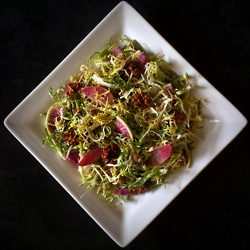 Hungry Mother always seemed like the kind of place we’d enjoy: local and sustainable sourcing, Southern-inspired food, and a great cocktail list. It’s been on our short list of places to try for years, and on a recent trip to Boston, we finally made it there.
Hungry Mother always seemed like the kind of place we’d enjoy: local and sustainable sourcing, Southern-inspired food, and a great cocktail list. It’s been on our short list of places to try for years, and on a recent trip to Boston, we finally made it there.
It’s easy to win hearts and minds with menu items like pimento cheese, bourbon-braised pork shoulder, and cheddar grits with house-made tasso, not to mention winning cocktails like the No. 43 (rye, tawny port, maple syrup, and bitters). But amid all of these decadent treats was a salad that sounded so tame that I actually felt a little boring for ordering it.
The buttermilk-chive dressing was what pushed me over the edge, luring me away from other options. That, I suppose, and the pecans, which I love but can’t get locally here in Northern California. What I hadn’t expected was that the farro — a humble, wheat-like grain — would be the star of the show, bringing a nutty depth to the dish that made it substantial enough to stand up to the rich main courses that followed.
I woke up the next morning dreaming about this salad, knowing I wanted to recreate it when we got home. I realized that with a few adjustments — walnuts for pecans, wheatberries for farro — I could make it entirely from locally sourced ingredients, making it a perfect candidate for our first Dark Days Eat Local Challenge meal of the winter.
Don’t be put off by the little ingredient-prep recipes that go into this dish; none are particularly difficult or time-consuming, and all of the parts can be stored for future use. And be sure that you’re picking through and using tender frisée leaves, as more-mature ones are unpleasantly grassy and spiky.


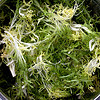
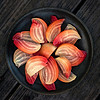
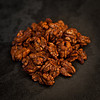
Autumn Salad with Wheatberries
– inspired by Hungry Mother; serves 2
6 cups loosely packed tender frisée leaves
3 to 4T buttermilk dressing
1/2 cup cooked wheatberries
roasted beet wedges equal to 1 large beet (or 2 to 3 small beets)
1 watermelon radish (or 3 to 5 small radishes), sliced thinly and cut into quarter-rounds
6 to 8 sweet-savory walnut halves
Toss all ingredients together, and serve on chilled shallow bowls or rimmed plates.
– Roasted Beets
Preheat the oven to 375°F. Scrub the beets and trim off tops and tails. Place in a baking dish about as deep as the beets are tall, and add 1/4 inch of water. Cover tightly with foil and bake until the beets are barely tender through (run a toothpick or cake tester through the center), about 45 minutes for large beets, 20 to 30 minutes for smaller ones. Remove from the oven and let sit, covered, for 5 more minutes. Uncover the beets, rub off the skin, and trim the tops and tails again. Cut into wedges and season to taste with salt. If not using within an hour or so, toss with a bit of olive oil; they will keep a few days in the fridge if well covered.
– Cooked Wheatberries
Note: For the 1/2 cup cooked wheatberries the salad requires, you’ll need 1/4 cup uncooked. However, it’s hard to cook less than 1 cup at a time. Leftovers freeze well, and they make a great base for grain salads, or in place of cooked rice in soups.
Soak the wheatberries overnight, or for at least a few hours. Bring the berries to a boil in a large saucepan of salted water. Reduce heat to a slow simmer and cook until tender but not blown out, about 2 hours. (Depending on freshness, wheat variety, and soaking time, this can take as little as 45 minutes or up to 3 hours.) When cooked, drain the berries and set aside.
– Buttermilk-Green Garlic Dressing
1/4 cup sour cream or plain yogurt
1/4 cup buttermilk
1/4 cup mayonnaise
1 tsp Champagne vinegar (or white-wine vinegar)
1 stalk green garlic, minced, or 1T minced chives
coarse-ground black pepper, to taste
salt, to taste
Mix all ingredients in a bowl, and refrigerate for at least an hour.
– Sweet-Savory Walnuts or Pecans
adapted from Epicurious
2 tsp sugar
1/4 tsp salt
1/4 tsp paprika
1T egg white
1 cup walnut or pecan halves (about 1/4 pound)
Preheat oven to 350°F. Lightly oil a rimmed cookie sheet, or line it with parchment.
Whisk together sugar, salt, and paprika in a small bowl. Whisk egg white in a medium bowl until frothy, then stir in nuts, mixing until evenly coated with egg white. Add sugar mixture and toss to coat.
Spread the nuts in the pan in a single layer. Bake, stirring once or twice, until dry and well toasted, about 20 minutes. Loosen nuts from pan, then cool completely.
Farmers and food artisans who created the ingredients for this week’s meal:
Massa Organics, Hamilton City: wheatberries
Star Route, Bolinas: frisée
Mariquita Farm, Watsonville: beets, watermelon radish
Glashoff, Fairfield: walnuts
Clover Organic, Petaluma: buttermilk, yogurt
Eatwell Farm, Dixon: Pastured eggs (for mayo)
Bariani, Sacramento: olive oil
Katz, Napa: Champagne vinegar
Knoll Farms, Brentwood: green garlic
Guisto’s Vita-Grain, South San Francisco: sea salt
Range Brothers, Capay Valley: pork chop
Exemptions: sugar, peppercorns
Boston, Dark Days challenge, locavore, recipes
13 Comments »




Posted by Anita on 04.04.10 9:43 AM
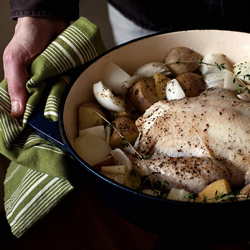 Spring has come to the blog: We made it to the end of the Dark Days Challenge! We’re excited to share some spring recipes with you soon. But before we head off into the sunshine, I’m sending a round of applause to all the other Dark Days bloggers who stuck it out to the end, especially our hostess, Laura at (not so) Urban Hennery.
Spring has come to the blog: We made it to the end of the Dark Days Challenge! We’re excited to share some spring recipes with you soon. But before we head off into the sunshine, I’m sending a round of applause to all the other Dark Days bloggers who stuck it out to the end, especially our hostess, Laura at (not so) Urban Hennery.
It’s been funny, pretending it was still Dark Days when the weather — and the market — make it clear that spring is upon us. Despite last week’s avocado orgy, we’ve tried to stick with the spirit of the challenge (and not torture participants in colder climates), using pantry goods and foraging in the freezer.
The weather has been obligingly wintery here in San Francisco this past week, so for our final Dark Days meal, we turned to a cool-weather dish I’ve been wanting to try for months. I came across this recipe in the River Cottage Cookbook, and was captivated: Why on earth had I never heard of pot-roast chicken before? We make pot roast with beef, and pork, and even lamb, but apparently the Brits (or at least Hugh F-W) know something we don’t. Dead simple, this one: Just chunk up whatever hardy vegetables you have on hand — vary the list below with the seasons, so long as there’s a starch and some onions — pop them in a big pot with a chicken in the middle, and Bob’s your uncle.
We made a few tweaks to the River Cottage recipe: Even once it was fully cooked, we found the chicken a little flabby and the pan juices a little thin for our taste. We solved both problems by popping the chicken back in the oven on its own for a few minutes to crisp the skin while reducing the pan juices a bit on the stove top. (Even if you don’t take this extra step, everything tastes delicious.) Cooked in this novel method, even the breast meat stays moist — a perfect ingredient for, say, chicken salad the next day. And should you have any leftover vegetables, they make a fine soup pureed with chicken stock and garnished with a bit of cream and a sprig of herbs.
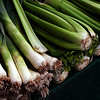



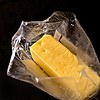
Pot-Roast Chicken and Vegetables
– adapted from The River Cottage Cookbook
1 chicken, 4 to 6 pounds
2T butter
2 tsp salt
freshly ground black pepper
2 onions
3 large carrots
3 stalks of celery
2 leeks
3 potatoes
2 bay leaves
1 cup white wine
1 cup unsalted chicken stock (or water)
3 sprigs of thyme
Preheat the oven to 375°F. Cut up the vegetables into large chunks. Smear butter over the top of the chicken, and season with salt and pepper. Place the buttered chicken in a large casserole or a deep lidded roasting pan, and surround with the chunked vegetables. Pour in the wine and stock, add the thyme, cover, and place in the preheated oven.
After an hour, remove the lid; stir the vegetables and baste the chicken with the fat on the top of the pan juices. Return to the oven, uncovered, for another 30 minutes or until the breast is browned and the juices run clear at the thigh.
Carve the chicken into individual portions and place in an oven-safe plate or pan; return it to the oven to get a little more brown and crispy while you finish the pan juices. Remove the vegetables to a serving bowl, and cover to keep warm. On the stove, simmer the juices in the roasting pan, reducing to a medium consistency (or as you like).
Farmers and food artisans who created the ingredients for this week’s meal:
Soul Food Farm, Vacaville: chicken
Catalán Family Farm, Hollister: onion, leeks, celery
Dirty Girl Produce, Santa Cruz: carrots
Little Organic Farm, Marin: potatoes
Spring Hill Cheese Company, Petaluma: Jersey butter
Souverain, Geyserville: white wine
Guisto’s Vita-Grain, South San Francisco: sea salt
…and our own homegrown bay leaves and thyme, and home-canned chicken stock
exemptions: black pepper
Dark Days challenge, locavore, meat, recipes
Comments Off on Dark Days, spring chicken




Posted by Anita on 03.29.10 8:19 AM
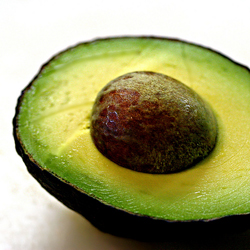 The first glimmers of spring are showing up at the farmers market, just as we’re on the home stretch of the Dark Days Challenge, and boy are we excited. Not so much for the strawberries; they’re still white in the center, and I’ll happily wait until they’re fully ripe. But we’re gorging ourselves on the new, tender asparagus, and we’re definitely making up for lost time in the avocado department.
The first glimmers of spring are showing up at the farmers market, just as we’re on the home stretch of the Dark Days Challenge, and boy are we excited. Not so much for the strawberries; they’re still white in the center, and I’ll happily wait until they’re fully ripe. But we’re gorging ourselves on the new, tender asparagus, and we’re definitely making up for lost time in the avocado department.
We put up jars of salsa last summer to help get us through the bleak winter months — without tomatillos, tomatoes, or chile peppers, Mexican food becomes downright impossible. But avocados defy preserving, and even on those rare occasions when we break down and buy an out-of-season avocado or two (sometimes it’s a guacamole emergency, I tell ya!) we always remember why it pays to wait. The watery, wan specimens that make their way here from Mexico or Chile just can’t compare with Will’s buttery, nutty avocados. So we wait. And wait. And wait. Rather impatiently, I might add. It’s one of the few winter deprivations that actually makes me cranky.
And so this week, we celebrated the avocado’s return to our kitchen with a big mess of tacos. It’s another one of those shopping-not-cooking recipes: Once you’ve got all the ingredients on hand, it’s a little bit of chopping, and a whole lot of gobbling. And should you have any leftovers, I can vouch that this filling, along with perhaps a little cheese and a soft-scrambled egg or two, makes an exceptional breakfast taco.
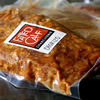

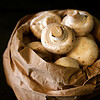
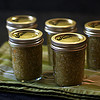
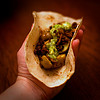
Chorizo-Potato-Mushroom Tacos
– adapted from Mexico One Plate at a Time
2 medium waxy potatoes (about 1/2 pound)
1/2 pound Mexican chorizo
1/4 to 1/2 pound mushrooms, any variety, sliced
1 small white onion, diced
1/2 cup or more tomatillo salsa (homemade or store-bought)
1 ripe avocado
6 to 8 fresh tortillas
Cube the potatoes and simmer in a pot of salted water until tender; drain and set aside in a medium bowl.
Saute the chorizo and onion in a wide skillet over medium heat until the sausage is cooked through. Using a slotted spoon, remove the sausage and onions to the bowl with the potatoes, leaving the rendered fat in the pan. Add the mushrooms to the pan and saute until softened and beginning to brown. Return the potatoes and chorizo-onion mixture to the pan and cook until the potatoes begin to brown.
Meanwhile, thoroughly mash the avocado in a bowl, then add the tomatillo salsa. Add more salsa until the mixture is like a sauce. Season with salt as needed.
Warm the tortillas in a skillet or griddle, or by running them over an open flame. Wrap them in a towel as you go, to keep them warm for the table. When tortillas are all warmed, move the taco filling to a serving bowl, and bring to the table with the avocado salsa and the warm tortillas. Let each person build their own tacos at the table with a scoop of the filling and a drizzle of the salsa in the middle of each tortilla.
 Farmers and food artisans who created the ingredients for this week’s meal:
Farmers and food artisans who created the ingredients for this week’s meal:
Little Organic Farm, Marin: potatoes
Fatted Calf, Napa: chorizo
Far West Fungi, Moss Landing: mushrooms
Catalán Family Farm, Hollister: onion
Will’s Avocados, Soledad: Avocados
La Palma Mexicatessen, San Francisco: fresh tortillas
…and our own home-preserved tomatillo salsa
Dark Days challenge, locavore, meat, Mexican, recipes
6 Comments »




Posted by Anita on 03.17.10 9:46 AM
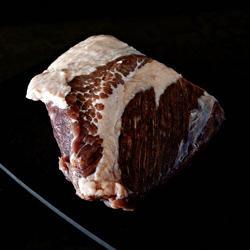 Every St. Patrick’s day we wonder: How did we let another year go by without making corned beef with all the trimmings? It’s simple, affordable, and delicious — too good to save for the holiday celebrations.
Every St. Patrick’s day we wonder: How did we let another year go by without making corned beef with all the trimmings? It’s simple, affordable, and delicious — too good to save for the holiday celebrations.
Sure, you can buy your corned beef at the market, but if you’d rather make your own using local meat and ingredients you can trust, it’s not difficult to brine it yourself. All it takes is a few minutes of measuring, a week of waiting, and a bit of refrigerator space.
We’ve made a number of recipes over the years, but the one we keep coming back to is the simplest. Hugh Fearnley-Whittingstall’s corned beef recipe serves 10 in its original ratios, so we’ve scaled it down to a more manageable size. If you do end up with extra meat, you’re in luck: In my book, corned-beef hash and Reubens are right up in leftovers heaven alongside the meatloaf sandwich.
Many recipes call for curing salt, but its only purpose is to maintain the pink-red color of the meat; it doesn’t serve any preservative purpose in corned beef, so we usually leave it out. (In charcuterie, it’s a necessary ingredient, but here it’s just for looks.) If you prefer the traditional blush, add 2 tsp of pink curing salt — also known as sodium nitrite or Insta Cure #1 — to the brine.
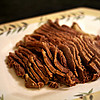
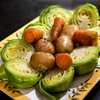

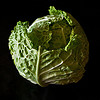

Corned Beef and Cabbage
– adapted from The River Cottage Meat Book
3 to 3-1/2 pounds well-marbled brisket
—
* for the brine:
2-1/2 quarts water
8oz demarara or light brown sugar
1-1/2 pounds coarse sea salt
1/2 tsp black peppercorns
1 tsp juniper berries
3 cloves
2 bay leaves
a sprig of thyme
—
* for cooking:
bouquet garni
1 carrot, chopped
1 onion, chopped
1 stalk celery, chopped
4-6 cloves garlic
—
* at the end:
3-5 large carrots, cut into large chunks
1 medium head cabbage, quartered, leaving core intact (or 4 small heads, halved)
5-10 potatoes, halved
2-3 turnips (optional), halved or quartered
Put all the brine ingredients in a medium saucepan and stir well over low heat until the sugar and salt dissolve. Bring to a boil, then remove from heat and let cool to room temperature.
Place your brisket in a large, non-metallic container (we use a large zip-top bag, but a deep casserole works well, too). Cover the meat with the cooled brine; weigh it down with a saucer or other non-reactive object if it floats (not necessary with the bag). Leave in the refrigerator for 5 to 7 days, turning every couple of days.
The day before you want to cook the corned beef, remove the brisket from the brine and soak it in cold water for 24 hours, changing the water at least once.
After the soak, place the brisket in soup pot with the bouquet garni, chopped vegetables, and garlic. Cover with fresh water and bring to a gentle simmer. Poach gently on top of the stove (or in a 275°F oven) until tender, about 3 to 3-1/2 hours. (A good test is to run a metal skewer through the meat; if it slides in easily, your brisket is done.) About 30 minutes before the brisket is done, add the remaining vegetables and simmer along with the meat.
Serve the hot corned beef cut into thick slices, along with the simmered vegetable chunks. (You can discard the smaller chopped vegetable bits in the broth.) Serve with fresh horseradish cream at the table.
 Farmers and food artisans who created the ingredients for this week’s meal:
Farmers and food artisans who created the ingredients for this week’s meal:
Prather Ranch, MacDoel: brisket
Catalán Family Farm, Hollister: onion, celery
Dirty Girl Produce, Santa Cruz: carrots, cabbage
Little Organic Farm, Marin: potatoes
Iacopi, Half Moon Bay: garlic
Happy Girl Kitchen Co., Big Sur: prepared horseradish
Clover Organic, Petaluma: sour cream
…and our own homegrown bay and thyme
Exemptions: sugar, peppercorns, juniper berries, cloves
Dark Days challenge, holidays & occasions, locavore, meat
8 Comments »




Posted by Anita on 03.15.10 9:48 PM
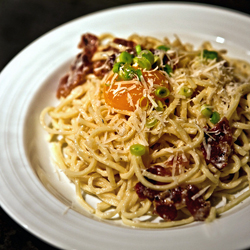 When you stock your larder with good quality staples, you’re able to create some amazing, quick weeknight meals. We’re lucky to live in a part of the country with access to a year-round supply of pastured eggs, a wide assortment of local artisan-made cheeses, and some truly excellent dry pasta, all from local sources.
When you stock your larder with good quality staples, you’re able to create some amazing, quick weeknight meals. We’re lucky to live in a part of the country with access to a year-round supply of pastured eggs, a wide assortment of local artisan-made cheeses, and some truly excellent dry pasta, all from local sources.
We’re also blessed to have good friends with amazing food-crafting skills. A case in point: Our friend Sean made his own house-cured guanciale, and generously gifted us with a chunk of the most delicious pork product we’ve tasted in recent memory.
Although Laura’s birthday dinner last Sunday could technically have been my Dark Days Challenge dinner for the week, I felt pretty happy knowing we’d be able to throw together an all-local meal, even though I’d missed the weekly farmer’s market during my Seattle trip. With Sean’s home-cured guanciale in our stash, along with a fresh dozen eggs from last week’s Soul Food Farm CSA delivery, we were only a few ingredients away from one of Cameron’s favorite simple suppers.
Two things set this pasta carbonara recipe apart from the usual. First, we added slivered green garlic as a garnish, an embellishment that’s sure to be frowned upon by carbonara purists, but one we’ll keep making as long as Knoll Farms keeps supplying our weekly fix. The second innovation is simple but revelatory: Separating the eggs and stirring the hot pasta with just the whites, then topping each serving with its own yolk to be stirred in at the table. This small trick lends the sauce a silky quality, and adds a little flair to the proceedings — just the trick for making a quick midweek supper worthy of an ingredient that took weeks to make.
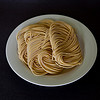
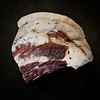

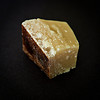
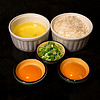
Spaghetti alla Carbonara
— adapted from Molto Italiano
1-1/2 T extra virgin olive oil
4oz guanciale (or pancetta)
1/2 pound spaghetti
3/4 cup freshly grated Parmesan
2 large eggs, separated
1 green garlic, white and light green parts, sliced thin
freshly ground black pepper
In a large pot, bring 4 quarts of well-salted water to a boil. Meanwhile, cut the gianciale into flat pieces, then combine the olive oil and guanciale in a large skillet over medium heat. Cook until the guanciale has rendered its fat, and becomes juicy and lightly browned. Remove the guanciale to a plate; remove the pan from the heat and set aside, reserving the fat in the pan.
Cook the spaghetti in the boiling water until just al dente. Add a good spoonful of the pasta water to the pan with the guanciale fat; drain the pasta. Return the guanciale to the pan, then add the pasta. Turn the heat back to medium-high and shake/toss the pasta with the water, fat, and guanciale for about a minute. Remove the pan from the heat and add 1/2 cup of the cheese, the egg whites, and freshly ground black pepper to taste; toss until thoroughly mixed (the egg whites will cook from the heat of the pasta).
Divide the pasta into nest-like piles between two warmed pasta bowls. Gently slide an egg yolk into the middle of each nest, then season with more pepper, the rest of the cheese, and the green garlic. Serve immediately, allowing each diner to stir the yolk into their own serving.
 Farmers and food artisans who created the ingredients for this week’s meal:
Farmers and food artisans who created the ingredients for this week’s meal:
Guisto’s Vita-Grain, South San Francisco: sea salt
Bariani, Sacramento: olive oil
Hedonia, San Francisco: guanciale (from Prather pork jowls)
Eduardo’s, San Francisco: spaghetti
Spring Hill Cheese Company, Petaluma: dry Jack cheese
Soul Food Farm, Vacaville: eggs
Tairwa Knoll Farms, Brentwood: green garlic
exemptions: black pepper
Dark Days challenge, Italian, locavore, meat, other blogs
3 Comments »




Posted by Cameron on 03.07.10 2:40 PM
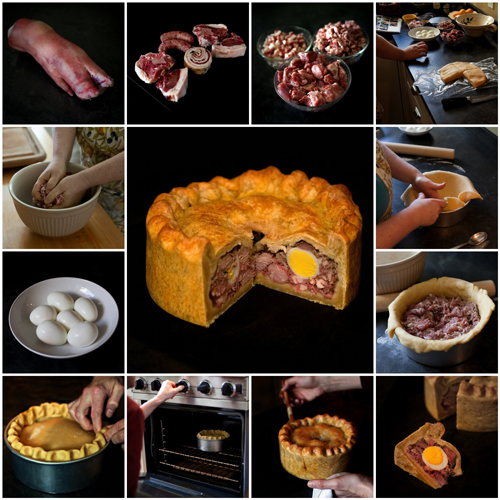
Tara, one of our very favorite meat-eating vegetarians, is on the San Francisco leg of her book tour. Happily for us, we’ve been able to see quite a bit of her when she’s not chatting with admirers, moderating debates between militant vegetarians and ethical carnivores, and seducing the crowds with her prose.
We got to talking about meat pies in general and pork pies in particular, and Tara told us about something that she had read in Danny, The Champion of the World, by Roald Dahl. The passage, which she first encountered when she was very young, describes a cold meat pie with hard-boiled eggs buried in it. The description struck a nerve, and it stayed with her into adulthood (apparently, she’s not the only one).
I love meat pies. Love, love, love, love. Cornish pasties, forfar bridies, empañadas, pot pies, steak pies, pork pies, you name it; there’s just something completely, utterly, and ineffably right about the combination of meat and pastry. Tara hadn’t even finished her story before Anita and I were waggling our eyebrows at each other and grinning like schoolkids. “So,” I asked the woman who has only recently begun to forge a relationship with meat after a lifetime of vegetarianism, “Want to make a pork pie?”
What fun! While Anita weighed and diced up the filling, Tara pulled together the hot-water crust with the quick, sure movements of a woman who has been cooking almost since she could walk. I caught the briefest of hesitations when she turned to the next step, but undaunted, she was quickly up to her forearms in a bowl of three different kinds of cold chopped pork. In honor of Mr. Dahl’s Danny, we buried hard-boiled eggs in the filling, and then I rolled out the top crust and crimped it in place.
This is my third time through this recipe, taken from The River Cottage Meat Book, and it’s a winner. The recipe doesn’t call for hard-boiled eggs, but they did just fine when we popped them in there.
The only downside of pork pie is that — because it’s best cold — you don’t get to taste it until the day after you’ve made it. We put together the pie on Sunday and it was our Dark Days Challenge dinner on Monday night, with pickles and mustard on the side.
Raised Pork Pie
– adapted from The River Cottage Meat Book
Filling
2# pork shoulder, cut into 1/2 inch cubes
8 oz fatty sausage meat (or ground pork belly)
8 oz salt pork, pancetta, or bacon, finely chopped
5 to 6 hard-boiled eggs, top and bottom trimmed so yolk shows through (optional)
12 sage leaves, finely chopped
leaves from 2 good sprigs of thyme, chopped
1 tsp salt
1 tsp coarsely ground black pepper
1 t ground white pepper
1/2 tsp ground mace
A good pinch of cayenne pepper
1 bay leaf
1 cup good pork stock that will set to jelly
Crust
7 T lard, diced
7 T butter, diced
Scant 1 cup water
4 1/4 c AP flour (approximately 630 g)
1-1/2 t salt
2 medium eggs, beaten, plus 1 egg, beaten, to glaze
Make the hot water crust pastry first. Put the lard , butter, and water in a saucepan and heat gently until melted; do not let it boil. Put the flour and salt in a mixing bowl. Make a hollow in the center and add the beaten eggs, stirring them gently around with a knife so they are half mixed with the flour. Pour in the melted fat and water and mix together to form a soft dough; add up to 3 1/2 T extra warm water if it is too dry. Knead gently, adding more flour if it is too sticky to handle. Wrap in plastic wrap and chill thoroughly (at least 1 hour).
For the filling, mix all the meats with the herbs, salt, and seasonings (except the bay leaf), so they are thoroughly combined.
Now assemble the pie. Preheat oven to 350 degrees. Cut off a generous quarter of the pastry and keep in the fridge, for the lid. On a floured surface, roll out the rest of the pastry into a 12 inch circle around 1/3 inch thick. Use this to line an 8 inch springform (or removable bottom) cake pan, pressing the pastry into the sides and flattening any overlap with your fingers. It should come 2-1/2 to 3 inches up the sides of the pan.
Fill with the seasoned pork mixture and push the bay leaf into the middle of it. (If you are adding eggs, lay down a thin layer of filling, place the eggs in a ring halfway between the center and the pie edge, and then add the rest of the filling around and covering the eggs.) Roll out the reserved piece of pastry into a circle about the size of the pan. Brush the edges of the lining pastry with a little beaten egg, and lay the pastry lid on top of the pie. crimp the edges together so they are sealed. Cut a 1/3-inch diameter hole in the center of the pastry lid.
Place the pie in the oven and bake for 30 minutes. reduce the temperature to 325 degrees and bake for a further 1-1/4 hours. If your top crust is concave instead of convex, a pool of juice and fat may form around the center hole during baking that you’ll want to remove with a turkey baster, or the crust may become soggy.
Remove the pie from the oven and carefully release the side of the pan. Brush the top and sides of the pie with beaten egg and cook for another 15 minutes to set the glaze. Take the pie out of the oven and allow to cool. The filling will have shrunk slightly, creating a cavity that is traditionally filled with jellied stock. When the pie is still a little warm, heat the jellied stock just until it’s pourable — not too hot! Carefully lift the edges of the center hold of the pastry with the tip of a knife, making sure you have good access to the cavity. Use a small funnel or, better still, a turkey baster to gently introduce the stock through the center hole. Tilt the pie from time to time to distribute the stock, then try and get a little more in. Stop when the stock begins to overflow from the hole. Leave the pie to cool, then put it in the fridge.
 Farmers and food artisans who created the ingredients for this week’s meal:
Farmers and food artisans who created the ingredients for this week’s meal:
Shasta Valley Farm, Gazelle: pork loin and pork sausage
Boccalone, Oakland: pancetta
Prather Ranch, MacDoel: leaf lard
Soul Food Farm, Vacaville: eggs
Guisto’s Vita-Grain, South San Francisco: flour, sea salt
Spring Hill Cheese Company, Petaluma: butter
…and our own homemade pickles, and homegrown celery and carrots (for pork jelly); sage, bay, and thyme
exemptions: pepper, mace, cayenne
Dark Days challenge, locavore, meat, recipes
15 Comments »




Posted by Anita on 02.28.10 5:33 PM
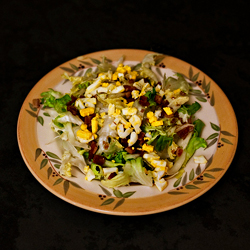 I used to work with a woman who brought in a sleeve of bagels, a tub of cream cheese, and a carton of orange juice every Monday. She parked them in the office fridge and then religiously ate the identical breakfast every morning, for weeks, months, years.
I used to work with a woman who brought in a sleeve of bagels, a tub of cream cheese, and a carton of orange juice every Monday. She parked them in the office fridge and then religiously ate the identical breakfast every morning, for weeks, months, years.
Just the memory of it makes me a bit twitchy, but also more than a little envious — think of how much time I could save if I could be content with monotony! But though I crave familiarity as much as the next person, I could never be one of those people who eats the same thing over and over, day in and day out. Heck, I can barely stand to repeat a dinner menu more than monthly.
So you can imagine my surprise when I found myself craving — and then making — the same salad three times in two weeks. Originally, the recipe appealed because I found myself the proud owner of three heads of escarole, courtesy of our latest Mariquita Farm mystery vegetable box. I’d intended to use this broad-leafed chicory in a variety of recipes: in Zuni bread salad, in brothy Italian sausage soup, and sauteed simply and scattered with pine nuts. But once I’d tasted this salad, I couldn’t stop making it.
It bears more than a passing resemblance to salade lyonnaise — that heavenly mixture of pleasantly bitter frisée and thick lardons of bacon, crowned with a poached egg — but requires a lot less fuss. You can boil the eggs and fry the bacon hours ahead of time, then whip everything together when you’re ready to serve. And it’s interesting enough to hold its own, or sit happily alongside a simple main course like the roast chicken we made for this week’s Dark Days Challenge dinner.
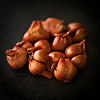


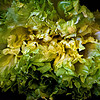
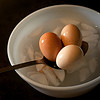
Warm Escarole Salad
– adapted from Bon Appétit
1 small head of escarole, torn into bite-size pieces (about 4 cups)
1 large slice bacon
1T extra-virgin olive oil
1T balsamic vinegar
3T finely chopped shallot
1 hard-boiled egg, diced
Over medium heat, cook the bacon until just crisp. Remove to paper towels, reserving the bacon drippings in the skillet. Chop bacon and set aside.
In a small bowl, whisk olive oil and vinegar together. Reheat the bacon drippings in the skillet; add shallots and sauté until slightly softened but not browned. Add olive oil mixture and stir until heated through. Season to taste with salt and pepper.
Divide escarole between two plates, and drizzle warm vinaigrette over the top. Sprinkle with egg and bacon, and serve warm.
 Farmers and food artisans who created the ingredients for this week’s meal:
Farmers and food artisans who created the ingredients for this week’s meal:
Mariquita Farm, Watsonville: escarole
Shasta Valley Farm, Gazelle (via Live Culture): bacon
Bariani, Sacramento: olive oil & vinegar
Dirty Girl Produce, Santa Cruz: shallot
Soul Food Farm, Vacaville: eggs and chicken
Guisto’s Vita-Grain, South San Francisco: sea salt
exemptions: black pepper
Dark Days challenge, locavore, recipes
4 Comments »




Posted by Anita on 02.22.10 12:12 PM
 I find it fascinating how some recipes languish in my clippings folder for months, years even, before I set my mind to trying them. It’s not that they don’t sound appealing — clearly they do, or I wouldn’t have bothered putting them aside — but maybe the moment’s not right, the ingredients aren’t at hand, the quantities are best saved for a party.
I find it fascinating how some recipes languish in my clippings folder for months, years even, before I set my mind to trying them. It’s not that they don’t sound appealing — clearly they do, or I wouldn’t have bothered putting them aside — but maybe the moment’s not right, the ingredients aren’t at hand, the quantities are best saved for a party.
Not every recipe gathers dust, though. Some send me sprinting to the kitchen as soon as I read them. And our friends Michael and Jen’s deep-dish pizza is one that I absolutely had to try right away.
I saw the original version of the recipe on Jen’s blog, Last Night’s Dinner, almost a year ago. We made it ourselves fairly soon thereafter, and we liked it. But we’re rather set in our pizza-making ways here, generally leaning toward thin-crust Italian-style pies when we decide to go the home-pizzeria route. Seeing Jen’s photos of Mike’s latest tweaks to his deep-dish recipe reminded me that we have a giant stash of Italian sausage waiting in our freezer, and got me thinking how well it would complement a sauce made from last summer’s home-grown tomatoes for this week’s Dark Days Challenge meal.
We gave Mike’s new edition a try — actually two tries in one week, that’s how much we like it — and weren’t surprised that it’s even better than the original pie. I made a few tweaks to the crust to adjust it to our taste; unfortunately, these changes turn Mike’s relatively painless recipe into a process that’s less convenient for weeknight preparation, so you may very well prefer his streamlined version. I often like to make and rise my pizza dough after dinner on one night, then tackle the second rise on the next. If your schedule’s a little more compressed, you can quick-rise the dough — as Mike’s master recipe does — and the end result will still be very, very good.
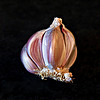
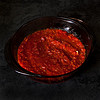
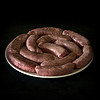
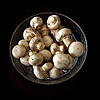

Deep-Dish Pizza
Adapted from Last Night’s Dinner, with crust tips from American Pie
– Crust
2 tsp active dry yeast
1 tsp sugar
1C warm water
3T unsalted butter, softened
1tsp table salt or 2tsp kosher salt
3C unbleached AP flour [15oz]
Grease a medium bowl with olive oil and set aside. In the bowl of a stand mixer fitted with a dough hook, combine the yeast, sugar, butter, and water; let sit 5 minutes or until frothy. Add the flour and salt, and combine at low speed. Increase speed to medium and mix until the dough pulls away from the sides of the bowl and crawls up the dough hook, about 1 minute. Add 1 to 2 tablespoons water if dough is dry; add 1 to 2 tablespoons flour if dough is wet. Continue to knead (in the mixer, or by hand) until dough is silky smooth and passes the windowpane test.
Form the dough into a ball and place in the oiled bowl, turning to coat all sides of the dough ball with oil. Cover with plastic wrap and let rise until it doubles in bulk, about an hour. Punch down, reshape, and let rise again (covered) in the refrigerator, at least 2 hours or overnight. Bring the dough back to room temperature 2 hours before you plan to roll it out. (You can also use the dough immediately after the first rise, or even let it complete the second rise at room temperature, but the texture and taste will be better if you proceed with the second, slower rise.)
– Sauce
1T extra-virgin olive oil
1 small onion, peeled and diced
2 cloves fresh garlic, peeled and sliced
2T shredded carrot
1-1/2 T chopped fresh thyme
a 28oz can of whole peeled tomatoes, crushed with your hands
1/4 C red wine or port
salt, to taste
In a medium saucepan, heat olive oil over medium heat. Add onion and a pinch of salt; sauté until soft and golden, then stir in garlic and cook until soft. Add carrot and thyme and continue cooking until the carrot is soft.
Add tomatoes and their juice, plus wine. Lower the heat and cook until the sauce is thick, about 30 minutes, seasoning to taste as you go.
– Finishing
1 recipe crust
1 recipe sauce
1/2 lb Italian sausage
2T olive oil
3/4 to 1 pound button mushrooms, quartered
8 oz mozzarella (if fresh, torn into 1-inch pieces; if drier, shredded — we like half and half)
1/2 cup freshly grated hard cheese (such as Dry Jack or Parmesan)
1/2 cup fresh basil or spinach leaves, chiffonade
Preheat the oven to 400°F.
Heat a 12-inch cast-iron skillet on the stove over medium heat. Add 1T olive oil and crumble Italian sausage into the skillet. Brown, adding more olive oil if needed, until cooked through. Using a slotted spoon, remove the sausage to a plate lined with paper towels, leaving the fat in the skillet. (If your sausage is on the fatty side, you might remove some of the fat, but be sure to leave the skillet well greased.)
While sausage is cooking, saute the mushrooms in a large skillet: Heat 1T olive oil over medium heat, then add the mushrooms and saute until they lose their liquid. Salt if desired, and set aside.
Pat or roll the room-temperature dough into a circle about 12 inches in diameter. Let rest for 5 minutes — this will help keep the crust from shrinking — then transfer it to the skillet. Press dough down into bottom of skillet and partway up the sides. Drizzle a little olive oil over the crust, then layer the sauce, sausage, mushrooms, and mozzarella. Bake on bottom rack of oven for 30 minutes. Start checking the pizza for doneness; you want the pizza crust to be golden brown, and the toppings to be just starting to brown. Remove pizza from oven and top with grated cheese and basil.
 Farmers and food artisans who created the ingredients for this week’s meal:
Farmers and food artisans who created the ingredients for this week’s meal:
Spring Hill Cheese Company, Petaluma: butter
Guisto’s Vita-Grain, South San Francisco: sea salt, flour
Bariani, Sacramento: Olive oil
Catalán Family Farm, Hollister: onion
Iacopi, Half Moon Bay: garlic
Ottimino, Occidental: Rancho Bello Zinfandel (for sauce)
Shasta Valley Farm, Gazelle (via Live Culture): Mangalitsa Italian sausage
Far West Fungi, Moss Landing: button mushrooms
Belfiore Cheese Company, Berkeley: mozzarella
Vella Cheese, Sonoma: dry Jack cheese
Mariquita Farm, Watsonville: spinach
Anchor Brewing, San Francisco: beer
…and our own homegrown carrots, tomatoes, thyme
exemptions: yeast, sugar
Dark Days challenge, locavore, other blogs, recipes
7 Comments »




Posted by Anita on 02.15.10 10:45 PM
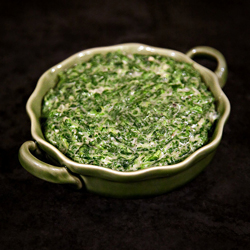 We hardly ever go out for big holidays like Valentine’s Day. It just seems so fraught, in so many ways. Somehow you always end up paying through the nose for a prix-fixe menu full of things that really aren’t what you’d want to order. And expectations are so high — not only because it’s everyone’s Special Night, but because, hey, you walked through fire to get that prime 8pm reservation — that there’s hardly any way a restaurant could rise to the occasion, much less impress.
We hardly ever go out for big holidays like Valentine’s Day. It just seems so fraught, in so many ways. Somehow you always end up paying through the nose for a prix-fixe menu full of things that really aren’t what you’d want to order. And expectations are so high — not only because it’s everyone’s Special Night, but because, hey, you walked through fire to get that prime 8pm reservation — that there’s hardly any way a restaurant could rise to the occasion, much less impress.
So for as long as I can remember, we’ve chosen to stay in and cook ourselves a special meal. This year, we both decided we wanted a classic steakhouse dinner: A big, crisp salad with chunky bleu cheese dressing, a nice grilled ribeye big enough to share, a giant baked potato with all the fixins, a luscious ramekin of creamed spinach, and a special-occasion bottle of red wine.
With a little careful shopping, we managed to combine our romantic Valentine’s Day dinner for two with this week’s Dark Days Challenge meal — a wonderful match, if I do say so. Better still, we got to spend our evening cooking together, rather than circling endlessly looking for parking and jostling for a harried waiter’s attention.
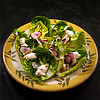
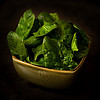
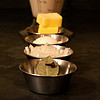


Steakhouse-Style Creamed Spinach
– serves 2
10oz fresh spinach
3T butter (divided use)
3T all-purpose flour
2T diced onion
1 small bay leaf
1 whole clove
2 C whole milk
pinch of nutmeg
Blanch spinach in large pot of boiling, well-salted water just until tender. Drain, then cool the spinach in a bowl filled with ice water. Drain well, then roll up spinach in kitchen towel and squeeze out as much liquid as possible. Transfer spinach to food processor and chop.
Melt 2T butter in skillet over medium heat. Add flour and stir until light golden. Stir in onion, bay leaf, and clove. Whisk in milk, stirring until mixture boils and thickens, about 10 minutes. Reduce heat to low and simmer, whisking frequently, until sauce is very thick. Remove bay leaf and clove, and add a pinch of nutmeg.
Add spinach to warm sauce. Simmer over low heat until spinach is heated through, stirring often. When ready to serve, stir in remaining tablespoon of butter, and season to taste with salt and pepper.
 Farmers and food artisans who created the ingredients for this week’s meal:
Farmers and food artisans who created the ingredients for this week’s meal:
Mariquita Farm, Watsonville: spinach
Spring Hill Cheese Company, Petaluma: butter
Guisto’s Vita-Grain, South San Francisco: sea salt, flour
Catalán Family Farm, Hollister: onion
Claravale Farm, Paicines: Raw milk
Little Organic Farm, Marin: potatoes
Clover Organic, Petaluma: sour cream
Prather Ranch, MacDoel: ribeye
Ottimino, Occidental: Rancho Bello Zinfandel
Star Route, Bolinas: Little Gem romaine lettuces
Point Reyes Farmstead Cheese, Pt. Reyes Station: Bleu cheese
…and our own homegrown bay and radishes
Exemptions: pepper, clove, nutmeg
Dark Days challenge, locavore, recipes
5 Comments »




Posted by Anita on 02.07.10 9:16 PM
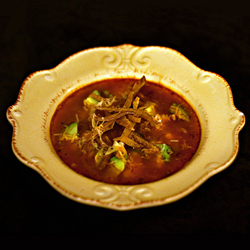 Yes, yes — soup again. I’d really hoped to have something better to share by the end of the week, but I’m still fighting the after-effects of a particularly nasty cold. Making dinner is doubly complicated: Not only do I not feel much like cooking, but I often have to trick myself into eating something I’m craving before my appetite disappears again.
Yes, yes — soup again. I’d really hoped to have something better to share by the end of the week, but I’m still fighting the after-effects of a particularly nasty cold. Making dinner is doubly complicated: Not only do I not feel much like cooking, but I often have to trick myself into eating something I’m craving before my appetite disappears again.
Early last week, the only thing I could really get worked up about making was tortilla soup. We’re still at least a month away from local avocados at our farmers market, but I couldn’t imagine this classic soup without them. Sometimes it’s worth it, I rationalized, to make an exception for an ingredient that has no reasonable local alternative.
As luck would have it, Cameron found semi-local organic avocados at our co-op — California is better than Mexico, right? And we have plenty of local tomatoes in the pantry, so I didn’t have to venture too far off the local path to satisfy my sick-kid whims.
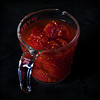

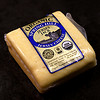

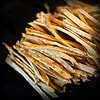
Sopa Azteca / Tortilla Soup
– adapted from Mexican Everyday
2 cups diced tomatoes in juice
2T ground pasilla or ancho chile
2T chicken fat (or mild vegetable oil)
3 garlic cloves, peeled
2 quarts chicken broth
1 large sprig epazote (optional)
2-1/2 cups cooked chicken, chopped or shredded
1 large ripe avocado, pitted, skinned, and cubed
6oz (about 1-1/2 cups) shredded mild cheese, such as asadero, Jack, etc.
6oz (about 4 cups) broken tortilla chips
1 large lime, cut into 6 wedges
Preheat the broiler. Drain the tomatoes, reserving the juice, and place on a parchment-lined rimmed cookie sheet. Broil the tomatoes until beginning to blacken; turn with a spatula and cook a little longer on the other side, until toasted and aromatic. Remove from oven and set aside.
Melt the chicken fat in a medium saucepan over medium-high heat. Add the onion and garlic and saute until softened. Add the ground chile and cook for another minute or two; be careful not to burn the chile — add water and/or adjust the heat if you smell it getting too hot. Remove the vegetables from the pan with a slotted spoon, leaving behind as much of the fat as possible, and transfer to the blender. Process until smooth, adding only as much of the tomato juice as you need to get a puree going.
Return the pan with the fat to medium-high heat. When hot, add the puree and stir constantly until the puree is thickened to a paste. Puree the roasted tomatoes and the reserved tomato juice, and add them to the pot along with the broth and the epazote. Bring the soup just to a boil, then reduce heat to medium-low and simmer for 15 minutes. Taste and season with salt. Add the chicken to the simmering broth and heat through.
Divide the avocado, cheese, and tortilla chips between four individual bowls. Serve the lime wedges separately at the table.
 Farmers and food artisans who created the ingredients for this week’s meal:
Farmers and food artisans who created the ingredients for this week’s meal:
Tierra Vegetables, Santa Rosa: chile powder and garlic
Soul Food Farm, Vacaville: chicken
Spring Hill Cheese Company, Petaluma: Jack cheese
Primavera, Sonoma: Corn tortillas (for homemade tortilla strips)
Mariquita Farm, Watsonville: limes
…and our own home-canned chicken stock and tomatoes, and homegrown epazote
Exemption: avocado (California organic)
Dark Days challenge, locavore, Mexican, recipes
5 Comments »




 Hungry Mother always seemed like the kind of place we’d enjoy: local and sustainable sourcing, Southern-inspired food, and a great cocktail list. It’s been on our short list of places to try for years, and on a recent trip to Boston, we finally made it there.
Hungry Mother always seemed like the kind of place we’d enjoy: local and sustainable sourcing, Southern-inspired food, and a great cocktail list. It’s been on our short list of places to try for years, and on a recent trip to Boston, we finally made it there.




























 When you stock your larder with good quality staples, you’re able to create some amazing, quick weeknight meals. We’re lucky to live in a part of the country with access to a year-round supply of pastured eggs, a wide assortment of local artisan-made cheeses, and some truly excellent dry pasta, all from local sources.
When you stock your larder with good quality staples, you’re able to create some amazing, quick weeknight meals. We’re lucky to live in a part of the country with access to a year-round supply of pastured eggs, a wide assortment of local artisan-made cheeses, and some truly excellent dry pasta, all from local sources.




























